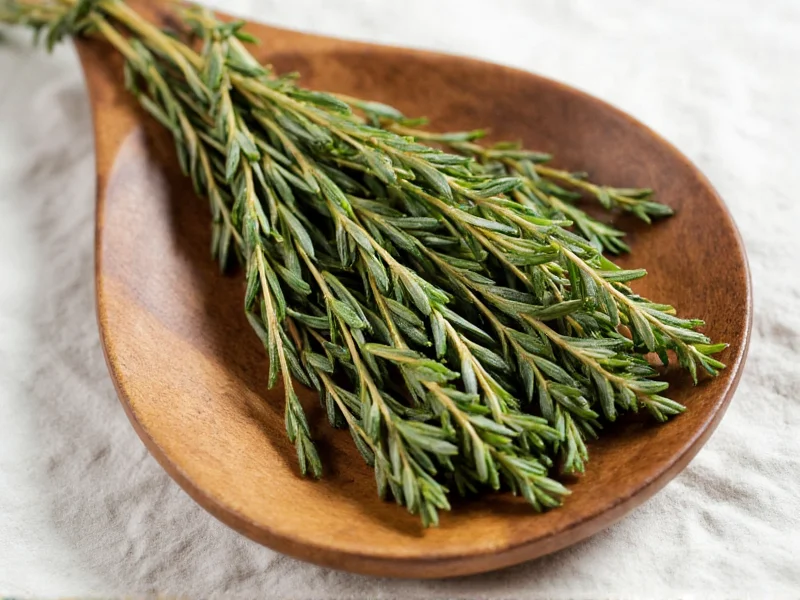Understanding Dried Thyme: Nature's Concentrated Flavor
Dried thyme represents one of the most practical and flavorful preserved herbs available to home cooks and professional chefs alike. The drying process removes moisture while concentrating the essential oils that give thyme its distinctive aromatic properties. Unlike many herbs that lose significant flavor when dried, thyme actually benefits from dehydration, developing deeper, more complex notes that enhance a wide variety of dishes.
Flavor Profile and Chemical Composition
The unique taste of dried thyme comes from its complex chemical makeup, primarily thymol and carvacrol. These compounds create its signature earthy, slightly medicinal flavor with subtle lemon and mint undertones. When properly dried and stored, thyme maintains approximately 80-90% of its volatile oil content, which is responsible for both its flavor and potential health benefits. The drying process actually increases the concentration of certain beneficial compounds while reducing water content, making dried thyme more potent by volume than fresh.
Dried Thyme vs Fresh Thyme: A Practical Comparison
Understanding the differences between dried and fresh thyme is essential for optimal culinary results. While fresh thyme offers brighter, more delicate notes, dried thyme provides deeper, more concentrated flavor that withstands longer cooking times. This makes dried thyme particularly valuable for dishes requiring extended simmering or roasting.
| Characteristic | Dried Thyme | Fresh Thyme |
|---|---|---|
| Flavor Intensity | 3x more concentrated | Milder, brighter notes |
| Best Used In | Long-cooking dishes, rubs, marinades | Garnishes, quick-cooking dishes, salads |
| Substitution Ratio | 1 tsp dried = 1 tbsp fresh | 3 tbsp fresh = 1 tsp dried |
| Shelf Life | 1-3 years (properly stored) | 1-2 weeks refrigerated |
| Flavor Development | Releases flavor gradually during cooking | Add late in cooking for best results |
Optimal Culinary Applications for Dried Thyme
Mastering the use of dried thyme requires understanding when and how to incorporate it into various dishes. For soups, stews, and braises, add dried thyme early in the cooking process to allow its flavors to fully integrate with other ingredients. The extended cooking time helps release and distribute its essential oils throughout the dish. When creating dry rubs for meats, combine dried thyme with complementary spices like garlic powder, onion powder, and black pepper for maximum flavor penetration.
For roasted vegetables, toss them with olive oil, dried thyme, salt, and pepper before roasting to create a beautifully caramelized exterior with herb-infused flavor. In tomato-based sauces, dried thyme works particularly well as its earthy notes complement the acidity of tomatoes. When making herb-infused oils, dried thyme provides more consistent results than fresh due to its lower moisture content, reducing the risk of bacterial growth.
Precision Storage Techniques for Maximum Longevity
Proper storage determines how long dried thyme maintains its flavor potency. Store dried thyme in airtight glass containers away from direct light, heat, and moisture. The ideal storage temperature ranges between 50-70°F (10-21°C). Avoid storing near your stove, dishwasher, or sink where temperature and humidity fluctuate. When stored correctly, high-quality dried thyme maintains optimal flavor for 1-2 years, though it remains safe to consume indefinitely if kept dry.
To test if your dried thyme still has flavor, rub a small amount between your fingers and smell it. Fresh, potent thyme will release a strong aromatic scent. If it smells faint or dusty, it's lost most of its essential oils and should be replaced. Never store dried herbs in the refrigerator, as the moisture content can cause condensation inside the container, accelerating flavor loss.
Evidence-Based Health Considerations
Dried thyme contains concentrated levels of antioxidants, particularly thymol and carvacrol, which research suggests may offer anti-inflammatory and antimicrobial properties. A comprehensive review published in the Journal of Agricultural and Food Chemistry noted that dried thyme maintains significant antioxidant capacity even after the dehydration process. While culinary amounts won't provide medicinal effects, regularly incorporating dried thyme into your cooking contributes to a phytochemical-rich diet.
It's important to note that dried thyme should complement, not replace, medical treatments. The concentrations of beneficial compounds in culinary usage are significantly lower than those used in clinical studies. However, as part of a varied, herb-rich diet, dried thyme contributes to overall dietary diversity that supports long-term health.
Selecting Quality Dried Thyme: What to Look For
When purchasing dried thyme, examine both appearance and aroma. High-quality dried thyme appears vibrant green to olive green (avoid brownish or yellowed product), with whole or mostly intact leaves rather than excessive powder. Crush a small amount between your fingers—the aroma should be immediately strong and pleasant, not musty or faint.
Consider buying from retailers who specify harvest dates or provide information about sourcing. Organic dried thyme often demonstrates better flavor retention as it's typically processed without harsh chemicals that can affect essential oil content. For the best flavor experience, purchase smaller quantities more frequently rather than large bulk amounts that may sit unused for extended periods.
Creative Applications Beyond Traditional Cooking
Dried thyme offers versatility beyond standard culinary applications. Create a simple herbal tea by steeping one teaspoon of dried thyme in hot water for 5-7 minutes, optionally adding honey and lemon. For natural home fragrance, combine dried thyme with other dried herbs like rosemary and lavender in a small bowl. When making homemade bread crumbs, mix dried thyme with toasted breadcrumbs for a flavorful coating for proteins or vegetables.
Some traditional culinary cultures use dried thyme in cheese-making processes to impart subtle herbal notes. While not common in Western cuisine, this technique demonstrates the herb's versatility across different culinary traditions and applications.
Common Questions About Dried Thyme
Understanding proper usage and storage helps maximize the culinary potential of this versatile herb. Many home cooks have specific questions about incorporating dried thyme into their cooking routines effectively.











 浙公网安备
33010002000092号
浙公网安备
33010002000092号 浙B2-20120091-4
浙B2-20120091-4